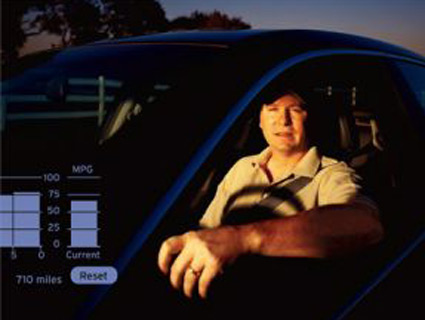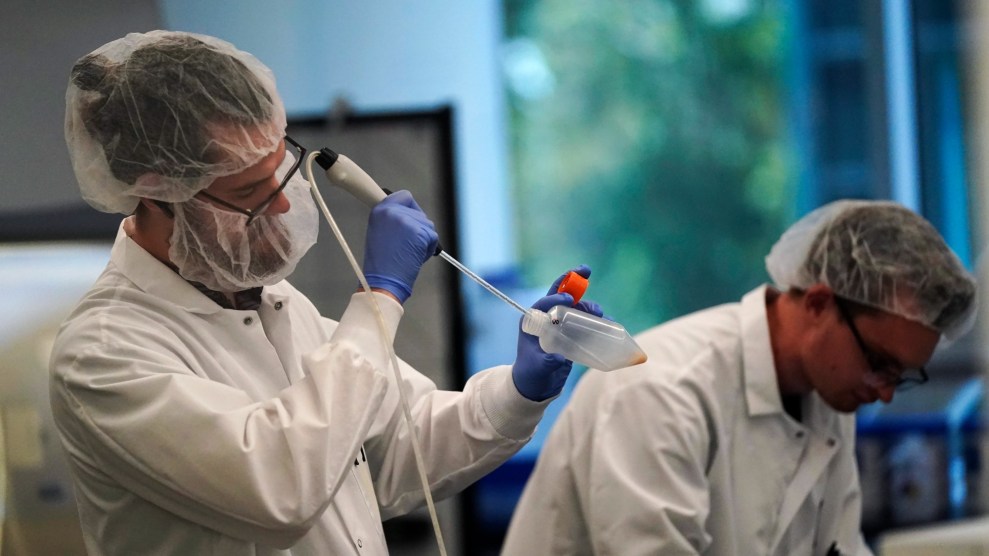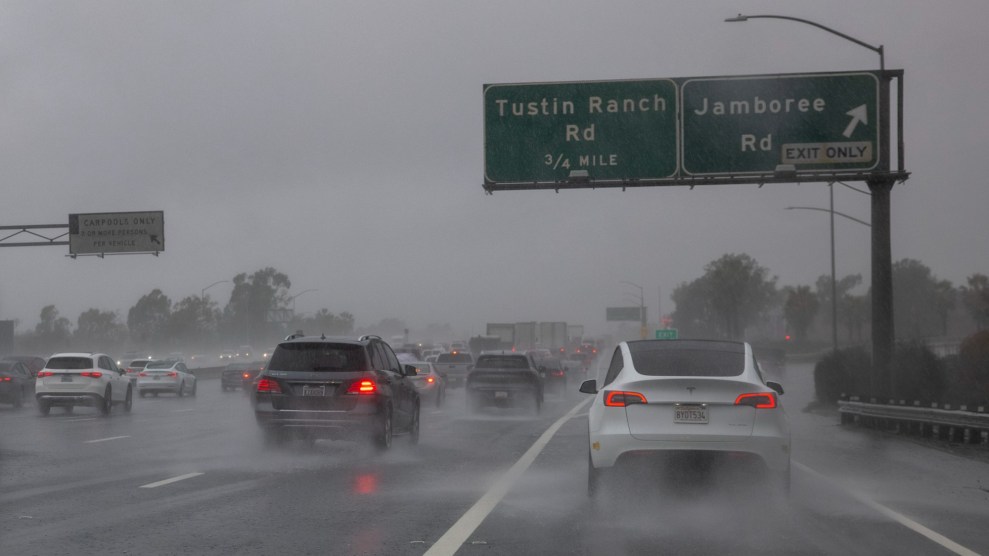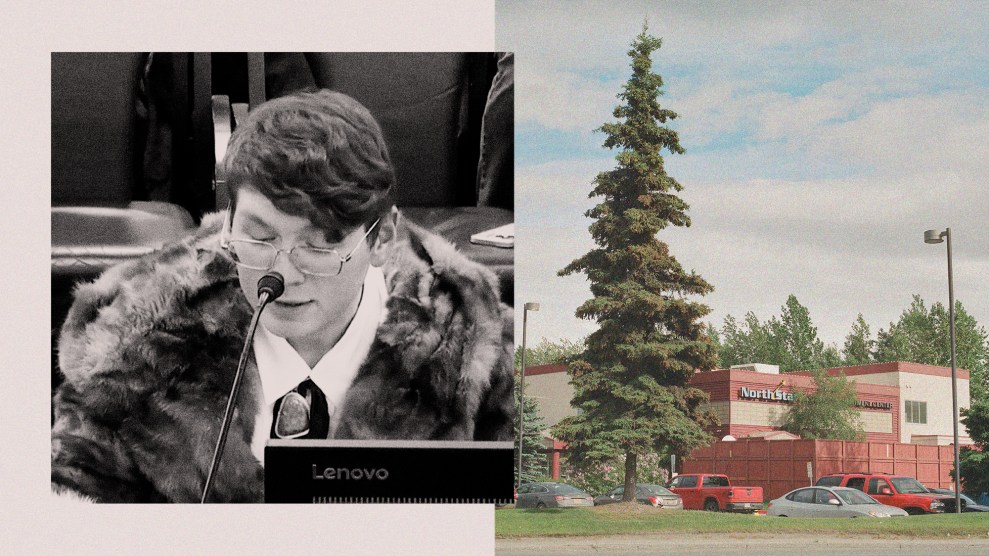
Photo: Chris Strong
On a midsummer Saturday in a sprawling Wisconsin parking lot, about a dozen people are milling about a candy-apple red Honda Insight. They’re watching Wayne Gerdes prepare for his run in Hybridfest’s mpg Challenge, a 20-mile race through the streets of Madison. Wayne is the odds-on favorite to win the challenge, in which drivers compete to push the automotive limits not of speed and power—a desire those gathered here consider old-fashioned and wasteful—but for the unsexy title of Most Fuel-Efficient Driver in the World.
Wayne is believed to be that driver, but he’s nervous, because all day long the hypermilers—the term Wayne invented to describe the band of brothers who push the limits of fuel efficiency—have been getting crazy-high miles-per-gallon readings, as much as 100 mpg. For the race, he’s borrowed a buddy’s Insight and, in order to decrease the car’s mass, jettisoned everything that’s not screwed down. Car detritus—a pillow, towels, cleaning supplies, a tool kit—sits neatly on a blanket on the macadam.
What can’t be jettisoned is Wayne himself, who at 6 feet 1 inch and 210 pounds looks too big to fit into this tin can two-seater. (“I would love to lose 60 pounds,” he tells me, “because it would help my mileage.”) In Wayne’s world, fuel efficiency is not about the car. It’s about the driver. Wayne doesn’t get high mpg marks by tinkering with engines or using funky fuels or even, most days, by driving a hybrid. He gets them by driving consciously—hyperconsciously. He takes out his wallet and his keys. Then he removes his sneakers. “We’ll put them on eBay,” cracks one of the onlookers. “He’s speeding,” someone says as Wayne exits the parking lot. “Look at him go.” Wayne is doing no more than 15 miles per hour. Before he’s out of sight, though, he turns a full loop on the exit road to slow himself down, so he doesn’t have to brake at a traffic jam ahead. Wayne hates braking.
Forty-five minutes later, Wayne is still driving the bucolic 20-mile course when raindrops as big as marbles begin falling and winds send trash hurtling across the parking lot. Everyone runs for cover, and I jump into a Toyota Prius owned by one of Wayne’s hypermiling buddies, Dave Bassage. Puddles and high winds are a hypermiler’s nightmare. “Nature’s putting on its own energy show,” says Bassage, watching the blasts of lightning through his water-splattered windshield. “This pretty much screws Wayne.”
two nights earlier, on a clammy 80-degree Chicago evening, I wait for Wayne at the curb at O’Hare International Airport. I first see his technique as the car he’s driving, a 2006 Honda Civic Hybrid, pulls over to pick me up. Drifts over, actually, like a jellyfish. Around Wayne is madness in motion: Drivers in four lanes are accelerating hard, weaving erratically, or grinding to a halt. To Wayne, these are the driving habits of the ignorant and the wasteful—which is to say, nearly all of us. Wayne’s car glides to a stop as if it has run out of gas. Wayne has stopped without braking.
The car is owned by his friend Terry Honaker, who, with his wife, Cathy, is along for the ride. Inside it’s hotter and even more humid than outside. As we take off—or, more accurately, as the vehicle rolls forward really slowly—I notice that all four windows are closed and the AC is off. I’m sitting in one of the most technologically advanced cars in the world, and it feels like I’m trapped in a fanless tollbooth in Biloxi, Mississippi, in August. We take the interstate to Wayne’s house. The speed limit is 55, and most of the traffic is zipping past at 75 or so, but Wayne hovers around 50 mph. He’s riding the white line on the right side of the right-hand lane.
“Why are you doing that?” I ask from the backseat. “It’s called ridge-riding,” he explains, using another term he’s invented. He ridge-rides to let people behind him know that he is moving slowly. I imagine it’s also a way to avoid dying plastered to the grill of a semi. Ridge-riding, Wayne explains, saves gas in the rain, as it gets the wheels out of the puddly grooves in the road created by more, let’s say, traditional drivers. “People are burning fuel to throw water in the air,” he says, adding that you can hear if you’re driving in the road’s grooves or out of them. That’s interesting, but I’m having a hard time concentrating, because my back and butt are beginning to stick to the seat. “Is anybody a little warm in here?” I ask.
I don’t think Wayne hears me, because, as a Chevy Tahoe whizzes by, he notes, “I imagine that it’s getting 10 to 13 miles per gallon climbing this hill. We’re getting about 80. It’ll drive you crazy.” I’m thinking that hypermiling consists of driving like a 90-year-old in a mobile sweat lodge, but I’m about to find out I’m wrong. Really, really wrong.
“Buckle up tight, because this is the death turn,” says Wayne. Death turn? We’re moving at 50 mph. Wayne turns off the engine. He’s bearing down on the exit, and as he turns the wheel sharply to the right, the tires squeal—which is what happens when you take a 25 mph turn going 50. Cathy, Terry’s wife, who is sitting next to me in the backseat, grabs my leg. I grab the door handle. As we come out of the 270-degree turn, Cathy says, “I hope you have upholstery cleaner.”
We glide for over a mile with the engine off, past a gas station, right at a green light, through another green light—Wayne is always timing his speed to land green lights—and around a mall, using momentum in a way that would have made Isaac Newton proud. “Are we going to attempt that at home?” Cathy asks Terry, a talkative man who has been stone silent since Wayne executed the death turn in his car. “Not in this lifetime,” he shoots back.
Wayne is paying attention to the road, not the banter. He’s had to turn the engine back on earlier than he usually does after taking the death turn. “I hit the turn at 50, 51,” he says. “I should have hit it at 52.”
i stay at wayne’s home, part of a modern suburban development between Chicago and Milwaukee on Lake Michigan’s western shore. It’s not the kind of place where people drive compact cars, much less hybrids. “There’s a Hummer over there,” Wayne says after we step inside, pointing to a neighbor’s house beyond his microwave. “And there’s a Hummer over there,” he says, pointing past his TV, the largest flat-screen I’ve ever seen outside of a sports bar. In the kitchen with us is Hobbit—he prefers that to his real name—another visitor who is staying at Wayne’s house while attending Hybridfest. Hobbit has a patchy beard and a braided ponytail and travels in bare feet. He looks and thinks like the ecoradical you might expect a hypermiler to be and confesses he’s surprised by Wayne’s home and lifestyle. “I thought you’d be living like a college student,” he says.
Unlike most hypermilers, the most fuel-efficient driver on the planet doesn’t own a hybrid. He sold his Honda Insight two years ago and bought a 2005 Accord for the luxury of power mirrors, heated leather seats, and a state-of-the-art navigation system. He uses the Accord for a hellacious two-hour commute to the Braidwood Nuclear Power Station, where he works as an operator. His wife drives a 2003 Acura mdx, a seven-seater with a 3.5-liter V-6 engine that advertises itself as “the suv benchmark.” Wayne also owns a 2003 Ford Ranger, which he used to haul 5,000 pounds of lawn care equipment when he had a landscaping business on the side. He’s also proud of his Exmark Laser Z sit-down mower. “I can mow an acre a gallon,” he says.
The morning after I arrive, Hobbit and I squeeze into the front seat of the Ranger to join Wayne on a milk run. He starts the truck—well, gets it rolling—by releasing the emergency brake and putting the gearshift in neutral before jumping out and pushing the 3,330-pound vehicle down his sloping driveway with the engine off. He jumps in and, without braking, turns right, swerves around a dead skunk in the road, and then takes a left turn—again without braking—to a stop sign. Ahead, the light is red. “This is a long light,” he says. “I’m screwed. We have to throw it away.” “Throw it away” is the phrase Wayne uses to describe what most of us do with gasoline. We throw gas away when we accelerate fast, when we turn on the air conditioning, when we leave heavy stuff in the trunk, when we drive with a roof rack, when we don’t change the oil, when we underinflate our tires, when we roll down the windows, when we speed, when we brake, or when we idle. Wayne might seem a radical at times, but he’s really a conservative: He doesn’t want to throw anything away.
Even parking is not a routine matter with Wayne, as I learn when he chooses an isolated spot in the strip mall lot. “This is potential parking with a face-out,” he says. Potential parking, Wayne explains, is when you park at the highest spot in a parking lot. That way, you rely on gravity to get going rather than on the ice—the acronym Wayne uses for the internal combustion engine. A face-out is like it sounds: facing out into the open lot, allowing a driver to avoid backing up, braking, and then moving forward. “Nobody uses it,” he says, “but they darn well should. It’s a nearly empty parking lot, and you see people jammed in nose to nose. It’s screwed up.”
As we’re driving out of the parking lot, Wayne comes to the top of a small hill and tells me he’s doing a fas. “What?” I ask. “That’s a forced auto stop,” he says, which is putting the car in neutral, turning off the engine, and gliding. It’s illegal in some states—with the engine off, you can lose your power brakes after a few pumps, and with older cars, you can lose your power steering—but it’s a favorite driving tool of many hypermilers.
Wayne loves acronyms almost as much as he loves FE (that’s fuel economy). d-fas is a “draft-assisted fas,” which means fasing while you’re tailgating an 18-wheeler to reduce air resistance. dwb means “driving without brakes,” which is not really driving without brakes—even Wayne doesn’t do that—but driving as if you don’t have brakes. P&G is a pulse and glide, which I still don’t understand, but Wayne defines it in his notes for his Hybridfest presentation this way: “In a nutshell, it includes a fas in many hybrid and non-hybrid automobiles to a lower target speed (some hybrids can be influenced into this mode of operation with the right application of multiple accelerator pedal inputs), reigniting the ice, re-engagement of the tranny with the rev match, and re-acceleration to a higher target speed, repeat.” Got it?
On the way home, a woman in a generic gray sedan zips around Wayne trying to catch a green light, but she’s too late. The light turns red and she slams on the brakes. “That made no sense,” Wayne says. “Now she’s all pissed off too,” Hobbit says. “She’s sitting there with the car running and she’s going to tear out of here,” adds Wayne, who is sitting up the hill a bit from the light, with the engine off. Of course, that’s just what she does. (One study found that jackrabbit starts and hard brake stops reduce travel time by only about 4 percent—that’s 75 seconds on a 30-minute trip.) As we approach the right turn back into his subdivision, Wayne, in a fas, coasts down to 30 mph, then to 25 mph, letting inertia do the job of his brakes. Three cars are bunched behind him, and a guy in a Ford Explorer honks. “They can honk all day,” Wayne says. “My turn signal’s been on for the last eighth of a mile.” The guy in the Explorer passes, shooting Wayne an exasperated look.
Although Hobbit has great respect for Wayne, he attempts to distance himself from what Wayne is now doing. “I don’t consider myself a hypermiler in this sense, because, um… ” Hobbit struggles to express himself delicately. “I try to conform to the traffic much more than he does. There’s a big difference there. I’m sure it will show in the mileage numbers.” As Wayne pisses another driver off, Hobbit gives up on diplomacy. “At some point, the survival instinct and trying to be courteous on the road comes into play, too.”
Wayne finally makes the turn. It’s not the death turn of the previous night; it’s a mini-death turn. “Because you guys are in the cab, and I’ve got milk in the back,” Wayne explains, “I can’t take the corner very fast.”
wayne’s driving obsession began after 9/11. Before then, he drove “75 miles per hour in the left-hand lane,” but in the wake of the attacks he vowed to minimize his personal consumption of Mideast oil. As he sees it, Osama bin Laden and Al Qaeda received their operating funds from all the U.S. consumers who bought Saudi oil. That money paid for the construction work that made bin Laden’s family rich. “If Osama bin Laden didn’t have the money to burn,” Wayne says, “he wouldn’t have been able to do what he did. There was a direct relationship between our addiction to oil and the World Trade Center coming down.”
Less consumption of Mideast oil would also make our economy less susceptible to spikes in the price of opec oil, which have triggered U.S. recessions. More than half the gas we pour into our vehicles in America is imported, and we send more than $4 billion a week abroad to buy oil. If we all got a 25 percent improvement in fuel economy (far less than the 50 percent improvement that Wayne and his hypermilers routinely get), we could reduce by half the oil we import from the Mideast for our cars. And then there’s global warming. “I’m not just doing this for myself,” Wayne told me before we met. “I’m doing this for my country and the world.”
But driving with Wayne, you get the feeling it’s not just about politics, and that’s confirmed when he tells me about his father. For 50 years, Robert Gerdes has been writing down the mileage he gets from each tank of gas. Wayne remembers the vacation his family took from Winthrop Harbor, Illinois, to Florida when he was eight. His father drove the family car, a Buick LeSabre, and hauled an 18-foot travel trailer loaded with camping gear. The Buick got seven miles per gallon on the trip. “Every time we hit a steep hill it was, ‘Whooooshhhh,’ like the flushing of a toilet,” says Wayne, “but it was flushing fuel. I’ll never forget that sucking sound of the four-barrel carburetor. We visited Disney World, but I don’t remember it.”
in 2002, wayne bought a Toyota Corolla to replace the 1999 Nissan truck he had been using for his daily commute to the power plant. Online, he saw that “guys in Priuses were bragging about 44 mpg, and I was doing better in a Corolla.” But it was driving his wife’s Acura mdx that moved Wayne up to the next rung of hypermiler driving. That’s because the suv came with a fuel consumption display (fcd), which shows mpg in real time. As he drove, he began to see how little things—slight movements of his foot, accelerations up hills, even a cold day—influenced his fuel efficiency. He learned to wring as many as 638 miles from a single 19-gallon tank in the mdx; he rarely gets less than 30 mpg when he drives it. “Most people get 18 in them,” he says. The fcd changed the driving game for Wayne. “It’s a running joke,” he says, “but instead of a fuel consumption display, a lot of us call them ‘game gauges'”—a reference to the running score posted on video games—”because we’re trying to beat our last score—our miles per gallon.”
If people could see how much fuel they guzzled while driving, Wayne believes they’d quickly learn to drive more efficiently. “If the epa would mandate fcds in every car, this country would save 20 percent on fuel overnight,” he says. “They’re not expensive for the manufacturers to put in—10 to 20 bucks—and it would save more fuel than all the laws passed in the last 25 years. All from a simple display.”
since early in 2005, when gas prices rose past $2 a gallon, drivers all over the country have become more attentive to fuel efficiency. But the hypermilers set themselves apart in an event they refer to as the Prius Marathon, which took place in Pittsburgh in August 2005. It was undertaken by five men: Wayne; Dan Kroushl, an electrical engineer from Wexford, Pennsylvania; Dave Bassage, a West Virginian who until recently worked for the Department of Environmental Protection; Rick Reece, a geospatial analyst from South Carolina; and Bob Barlow, a Virginia attorney. They had all met online.
Kroushl got the idea after driving his Prius earlier that spring on a 15-mile portion of Route 65 near his home, when he was able to sustain 99.9 mpg, the highest reading that a Prius fcd can record. He posted what he had done online and asked if anyone had a device that could record higher mpgs. But nobody believed he had even reached 99.9. The car has a combined city/highway epa mpg estimate of 55, and even hypermilers with Priuses were only posting mpgs in the 60s and 70s. Kroushl wanted to prove the doubters wrong, so he invited other hypermilers to Pittsburgh to run the same stretch of Route 65—15 miles up and 15 miles back. Their goal was to break the record for most miles on a tank of gasoline in a Prius, which was 1,316 miles, recorded by a Japanese driver, at 85.85 mpg. But the American version of the car has a 12.8-gallon tank rather than the 15.9-gallon tank in the Japanese Prius. That meant the five men would have to top the Japanese mpg by about 20 percent, which would mean they’d have to sustain 100 mpg over 48 hours. Bassage described the event this way: “We’re coming from all points of the compass to have fun going nowhere for a whole weekend in Pittsburgh.”
The hypermilers cracked 100 mpg in their first four four-hour shifts. Back at their hotel, they posted fuzzy digital photographs of the Prius’ fcds on greenhybrid.com.
On their first round, the men posted mpgs in the low hundreds, but as they drove, they talked on the phone, sharing fuel-saving tips with each other. On Saturday, Reece got 114.7, and Kroushl reached 115. On Sunday, Wayne beat 120. “I’d be getting 105 miles per gallon,” Bassage told me, “and thinking I let down the team.” By Sunday night, Kroushl, who had launched the endeavor, was getting sick of driving, and his wife had made it clear she wanted him to stop the nonsense and get home, so he began turning on the air conditioner and the defroster, to drink up gas faster. “The ‘low fuel’ light flashed for over nine hours,” Bassage says. When the Prius, with Kroushl driving, finally ran out of gas and rolled to a stop, the five men had clocked 1,397 miles from just one 12.8-gallon tank of gas—a new record. They had averaged 109 miles per gallon.
in order to reacquaint himself with the car he’ll be driving the next day in the mpg Challenge, Wayne borrows an Insight for the 120-mile drive to Hybridfest. While Wayne drives, he reminisces about one of his sweetest—meaning most fuel efficient—drives of all time, in his Honda Accord last summer. “I was going about 70 miles per hour catching up with a truck, in the late evening, and I had a tail wind. I went into a d-fas, down the bowl over the top of a hill, and I coasted almost three and a half miles. It ended at 40 miles per hour…. It was a once-in-a-lifetime. I’ll probably never experience it again. The hypermiling gods were with me.”
I ask him what the equivalent feat would be for a baseball player. “Three grand slams in a game,” he says. A great home run hitter needs sharp eyes, strong wrists, and exquisite timing. And a great hypermiler? “Foot control, hand-eye coordination, and anticipation,” he says. “It’s like a moving chess game, where the pieces aren’t stationary.” Like all transcendent athletes, Wayne anticipates the action on the field—in his case, the road—before it unfolds. “I’m making micro-adjustments on a continual basis,” he says.
Fearlessness might be another trait that Wayne neglects to mention. At one point in our drive, Wayne approaches a truck to ride its draft. The wind whipping around the semi buffets the Insight, which weighs just 1,800 pounds. I offer Wayne some cashews, and as he takes a handful, his foot comes off the pedal slightly and the Insight drifts a few car lengths back. A black Infiniti suv squeezes between us and the truck. Wayne rides its butt. The Infiniti moves back into the left lane and zips away. “We pressured him so we could get our target back.” I offer him more cashews, but he declines. “I have to pay attention,” he says. He creeps back toward the truck. We’re at two car lengths…. Wayne takes a call from some friends in another car…. One car length…. I thump an imaginary brake pedal with my foot, just like my mother used to do while riding with me. Wayne, not a touchy-feely guy, puts his hand on my leg to reassure me.
A few minutes later, he slaps the wheel. “Damn. I forgot my ice vest.” The vest, which he uses at the nuclear plant when he has to work in really hot rooms, “is kind of my secret weapon,” he says. “You can drive at 95 degrees with an ice vest, and it doesn’t feel like 95.” Wayne expects his car will be extremely toasty during the mpg Challenge. “No electricity, no air, no fans,” he says. “No nothin’.”
the three dozen men—no women sign up to compete—begin driving the 20-mile course of the Hybridfest mpg Challenge at about 9 a.m. Wayne is the favorite—”I have a target on my back,” he says—and the star of the show. “It’s like he’s a member of Kiss,” says Tony Schaefer, a Hybridfest fan. Wayne expects that his most serious contender in the mpg Challenge will be Randall Burkhalter, the only driver to ever break one of Wayne’s mpg records. This summer he passed Wayne’s 92.8 mpg lifetime average for the Honda Insight, and his mark is now up to 95.4 mpg. Like many hypermilers, the two met online at websites such as cleanmpg.com, greenhybrid.com, and priuschat.com. Wayne finds Burkhalter in the hot midday sun after Burkhalter has just finished his run, the best of the day: a 108.5 mpg average in his Insight. Wayne slaps him on the back to congratulate him, calling him “the top dog.” Burkhalter thanks Wayne for all he’s taught him, adding, “We’re the head-butters. We’re the rams butting horns in the mountains.”
A few minutes later, a shout comes from the finish line that there’s a new front-runner. His name is Justin Fons, and he’s just 17 years old. He clocks 117.2 mpg in an Insight. Afterward, Justin explains that his father taught him how to drive, but that “the person I learned to drive efficiently from is Wayne Gerdes.” By mid-afternoon, Mike Dabrowski, an inventor, tops Justin’s mark, finishing the course at 121.9 mpg. But Dabrowski has the advantage of an extra battery in his Insight that connects to a fifth wheel he lowers to the ground hydraulically from the rear axle—which is why the other hypermilers call him “Mr. Fifth Wheel.” Wayne doubts that it’s possible to beat 121.9 mpg with four wheels. As he’s about to take the course for the last run of the day, he tells the woman who signs him in that she should write “Mike Dabrowski” in the winner’s slot.
by the time Wayne enters the lot from his run, it’s past 5 p.m., and the other hypermilers have retreated from the storm and are off to Hybridfest’s happy hour. Wayne’s cap is off and his head, soaking wet, is sticking out the window because his breath has fogged up the windshield, and he refuses to turn on the defroster. Wayne honks to get a judge to run through the rain to record his fcd. It reads as high as the Insight can record: 150 mpg. Afterward, the Insight’s owner hits a switch that shows Wayne’s mark in kilometers per liter, which has a higher limit. It reads 1.3 L/100 km. That’s 180.91 mpg. Later, at the awards dinner, Wayne is presented with a one-year subscription to Green Car Journal and a $25 gas card. For all we know, Wayne’s still using it.
ridge-ride vb to drive an automobile with one’s right wheels touching the right white line. Used to avoid puddles and excess friction and to alert approaching vehicles that one is moving slowly.
d-fas: draft-as·sis·ted forced au·to stop
n a fuel-saving driving technique in which one turns off the engine and tailgates a large truck in order to lower one’s wind resistance.












